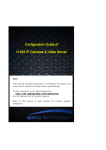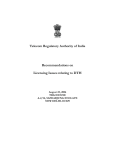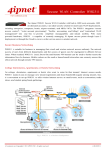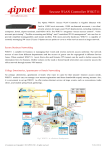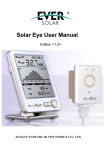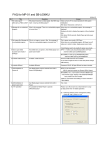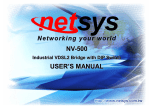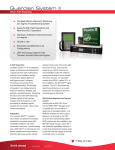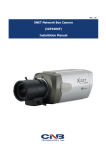Download Speco NVR User Manual
Transcript
Aug. 2010, Rev.6 Contents 6. Event Log Management 6.1. Event Log Window Notice 1. Introduction 1.1. Important Notice 7. Remote Video Storage (RVS) Management 7.1. RVS Control of IP Camera or Video Server 2. Installation of Speco-NVR 8. Virtual System Controller 9. Screen Lock & Unlock 10. E-Map 10.1. E-Map (GUI) 10.2. Addition and Deletion of Map Image 10.3. Placing MAP ICON 10.4. Placing Camera ICON 10.5. Locking/Unlocking the locations of the ICONS 10.6. MAP and Camera Status Indication 10.7. Connection to the Camera for Live View 10.8. Event Display 10.9. Relocating the Functional Windows 3. Screen 3.1. Functional Buttons and Indicators 3.2. Video Display Window 3.3. Quick Control Pop-Up Menu 3.4. Summary of Buttons 4. First Connection to Live Video 5. Detailed Description 5.1. Screen Layout 5.2. IP Set Up 5.3. Hard Disk Configuration 5.4. Alarm Recording 5.5. Recording Schedule 5.6. Playback 5.7. Live Connection and Recording 5.8. Bidirectional Audio 5.9. Still Image Capture 5.10. Rotating the Video 5.11. Remote Management 5.12. Sensor and Motion Alarm Indication 5.13. Remote Relay On/Off 5.14. Video and Audio Adjustment 5.15. PTZ and Camera Control 5.16. Video crop 5.17. Digital PTZ User Guide Rev 1.0 Appendix A. Recommended CPU/Graphics Card Specifications B. HDD Space Calculation C. Converting ICF file to AVI file Page 2 Notice – Must be read before you start Speco-NVR!! • Dedicated HDD is needed for the recording of the video data. – Add HDD solely for recording the data or make a partition on the HDD – The HDD or the partition for the recording should not contain data other than the data recorded by Speco-NVR. • Avoid following conditions to prevent System Crash or Reboot – Automatic Windows Upgrade Setting • If you specify the time for the automatic upgrade of your windows operating system, the automatic upgrade can cause reboot or system halt. • Automatic upgrade of the windows operating system is not recommended. – Multi monitor device driver for the NVIDIA video chip set can cause reboot or system halt. We do not recommend to use video cards using NVIDIA chip sets. • Recommended settings of the frame rate and data bit rate. – D1 size video : set the frame rates less than 15FPS. – CIF size video : make sure to set the summation of the bit rates from all video channels less than 50Mbps. User Guide Rev 1.0 Page 3 1. Introduction • Speco-NVR is a PC application program package targeted for use on a centralized real time video monitoring and recording system based on network cameras, video servers. • Speco-NVR needs a high performance PC. It is recommended to install Speco-NVR on a highly reliable hardware platform such as workstation. And Windows XP is recommended for the OS. – Speco-NVR shows the maximum stability and the performance when the PC is running no other application programs. – Basic screen of Speco-NVR includes up to 16 videos. • Speco-NVR supports all network cameras supplied by Speco. • The key features of Speco-NVR are : – – – – Supports up to 64 channels Live monitoring, Recording, Remote management of the network cameras. Various recording modes : Schedule, Manual, Alarm, Motion triggered A separate playback screen that can handle up to 16 simultaneous playback without interrupting real time monitoring. – Separate Event Log management – Integrated Pan/Tilt/Zoom control. User Guide Rev 1.0 Page 4 1. Introduction • The basic display screen of Speco-NVR consists of up to 16 video windows. Up to 4 basic display screens can be launched simultaneously to support up to 64 channels. • These screens can be shown on a single large screen or can be displayed on multiple display monitors. When using multiple monitors, make sure to install sufficient graphic card on your PC. User Guide Rev 1.0 Page 5 1.1. Introduction – Important Notice • Time reference of Speco-NVR – Speco-NVR includes the features that need time reference. Speco-NVR refers to the time set on the PC for the operation. It is very important to keep the clock of the PC precise. – The time which is displayed beneath each screen in white color for real time connection is the time information sent from the network camera. • Do not change the parameters related with network configuration while the SpecoNVR has a video connection with corresponding device. • Do not run application programs other than Speco-NVR on the same PC. This can cause instability and performance degradation of the Speco-NVR. User Guide Rev 1.0 Page 6 1.1. Introduction – for Windows Vista Windows Vista and Windows 7 users need to configure UAC (User Access Control) and Privilege Level for proper recording and still video capture in Speco-NVR and Web Viewer. Follow through the details in this document to ensure the setting. <Windows Vista> 1. UAC (User Access Control) configuration 1) Double-click “User Accounts” in control panel 2) Double-click “Turn User Account Control on or off” 3) Uncheck “Use UAC to help protect your computer” 1 2 3 User Guide Rev 1.0 Page 7 1.1. Introduction – for Windows Vista <Windows Vista> 2. Privilege Level Control 1) Select “Speco-NVR” icon on the desktop 2) Click right mouse button and select “Properties” 3) Check “Privilege Level” in “Compatibility” tab 1 3 2 User Guide Rev 1.0 Page 8 1.1. Introduction – for Windows 7 <Windows 7> 1. UAC (User Access Control) configuration 1) Double-click “User Accounts” in control panel 2) Double-click “Change User Account Control setting” 3) Set to “Never notify” 1 3 2 User Guide Rev 1.0 Page 9 1.1. Introduction – for Windows 7 <Windows 7> 2. Privilege Level Control 1) Select “Speco-NVR” icon on the desktop 2) Click right mouse button and select “Properties” 3) Check “Privilege Level” in “Compatibility” tab 1 3 2 User Guide Rev 1.0 Page 10 2. Installation of Speco-NVR • Install “Speco-NVR” S/W from the material CD. • Program installation will continue automatically and after the installation a launcher icon will be created on your desktop. • To play the recorded video file in Event Log Window, “icfPlayer” program will be installed automatically upon the installation of Speco-NVR. • For the sake of stability and improved performance, Speco-NVR is designed to use dedicated HDDs for recording the AV data. • Never use the HDD assigned for recording the AV data in Speco-NVR to save other files or programs. Speco assumes no responsibility caused by failure of observing this restriction. User Guide Rev 1.0 Page 11 3.1. Screen – Functional Buttons and Indicators Clone Window ON/OFF Button Channel Status Indicator Display Ratio Swap Change Channels Displayed Screen Lock Full Screen Display Screen Configuration Remote Relay On / Off Display Unit (DU). The smallest DU is called MDU (Minimum display Unit). This can be called as Channel when connection information is set up User Guide Rev 1.0 Focus Control Page 12 Pan / Tilt Control Zoom Control 3.2. Screen – Functional Buttons and Indicators Magnify Highlighted Channel Quad Mode Display Including Highlighted Channel HDD Usage Indicator Manual Recording Control Bidirectional Audio ON/OFF Live Connection Control Connect to Admin Page Still Video Capture Sensor and Motion Indicators for Each of 16 Channels Rotate Video By 180 Degree RVS Control E-map Virtual Controller for PTZ Camera Audio/Video Control Move to PTZ Home Centering Move to Preset Position User Guide Rev 1.0 Close NVR PTZ Parameter Set-up Page 13 3.2. Screen – Video Display Window • Video display window is an area that displays video sent from the locations being monitored. The window can be divided into 16 sub-screens called Display Unit (DU). Each DU has video display area and status indicator area. • Channel Status Indicator Indicates the presence of recording schedule. YES ( Recording in progress ( ) / Recording stopped( Indicates whether audio is enabled ( ) or Not ( Indicates whether bidirectional audio is enabled ( Indicates the presence of new event( ), NO ( ) ) ). ) or Not ( ) or no new event ( ). ) Indicates number of connected users • Messages – When there is no live connection, the message area indicates whether connection information is programmed or not (Assigned / Not Assigned). – When the channel is in live connection, the message area displays time and channel description. The time displayed in the message area is the time set on the device sending the video. Remember that this time can be different from the time set on the PC. – The size of the video is displayed in QCIF to UXGA. User Guide Rev 1.0 Page 14 3.3. Screen - Quick Control Pop-Up Menu • Locate the cursor on each DU and press right mouse button to enable pop-up menu. • Simple controls indicated on the right can be initiated for each channel. • Move the cursor to desired operation and press left mouse button to start the operation. User Guide Rev 1.0 Page 15 3.3.1. Screen – Summary of Quick Controls Menu Play Make connection with selected network camera. Stop Disconnect selected network camera. Camera Assignment Modify information of selected network camera. Camera Admin Run Administration Tools of selected network camera. Start Recording Start recording from selected Display Unit. Stop Recording Stop recording of selected Display Unit. Digital PTZ Video Cropping RVS Control System Controller PTZ Control Show Information Display UI-Lock User Guide Rev 1.0 Description Toggle digital PTZ function in selected Display Unit. Select region size of video cropping. Run RVS control. Run virtual keyboard controller. Run additional PTZ actions. Session Count Display number of connections that connected with network camera. Packet Loss Ratio Display packet loss ratio of network connection between PC with network camera. Frame Rate Display average frame rate per second of network camera. Original Ratio Show Status Bar Toggle the display ratio as original and fit. Toggle the display status bar on and off Lock up NVR control interface to prevent unsecured access Page 16 3.3.2. Screen – Quick Controls (View Original Size) 1 Select a channel 2 Select the View Original Size from pop-up menu. 3 The display window size follows setting in Administration tools User Guide Rev 1.0 Page 17 A new window will pop up with original video size 3.3.2. Screen – Quick Controls (View fullscreen size) 1 Select a channel 2 Select the View Fullscreen Size from pop-up menu. 3 The display window size follows video resolution setting of screen User Guide Rev 1.0 Page 18 A new window will pop up with fullscreen video size 3.3.2. Screen – Quick Controls (Show Information) 1 Select a channel 2 Select the Show Information from pop-up menu. MENU Description Session Count Display how many connection made with camera. Show all SESSION COUNT Turn on „session count‟ on all channel in screen. Packet Loss Ratio Display the ratio of network packet loss. Show all PACKET LOSS RATIO The feature display the informations that related with video streaming from connected network camera User Guide Rev 1.0 Frame Rate Show all FRAME RATIO Page 19 Turn on „packet loss ratio‟ on all channels in the screen. Display the average frame rate per second. Turn on „frame ratio‟ on all channels in the screen. 3.3.2. Screen – Quick Controls (Display) 1 Select a channel 2 Select the Display from pop-up menu. MENU Desciption Original ratio The video image in selected DU keep original display ratio. The video image will not fit to DU size. Show all ORIGINAL RATIO Show status bar Show all STATUS BAR The feature display the informations that related with video display from connected network camera User Guide Rev 1.0 Page 20 Turn on „original ratio‟ on all channels in screen. Display status bar on bottom of DU. Turn on „status bar‟ on all channels in screen. 3.4. Summary of Buttons Magnify the highlighted channel to occupy entire display area. Display the highlighted channel and the following 3 channels in 2 x 2 mode. Return to original screen layout. Display former 1 or 4 channels in the display area following the settings of the display. Display next 1 or 4 channels in the display area following the settings of the display. Connect (and view) or disconnect to the entire channels which are configured. Start or stop recording of A/V data from all connected channels. Show the percentage of the HDD usage. Capture a still video of the highlighted channel. Flip the video of the highlighted channel. Enable/Disable bidirectional audio communication for the highlighted channel. A control window for the audio and video adjustment is launched. Connect to the admin page of the highlighted channel. User Guide Rev 1.0 Page 21 3.4. Summary of Buttons If the highlighted channel product have internal storage, a new window for the control of the HDD is launched. Virtual controller for controlling PTZ camera is launched. This is applicable only for OPTZ36XI, OPTZ36XO. When this button is activated, the camera center is moved to the point where the mouse click is made. Displays preset positions. If one of the list is selected, the camera moves to selected preset position. A new control window for setting various PTZ parameters is launched. Move the camera to home position. Move the camera to UP/DOWN/LEFT/RIGHT. Zoom In or Zoom Out. Move the focus to near position. * These controls are available when the channel is equipped with proper PTZ features. User Guide Rev 1.0 Automatic focus adjustment Move the focus to far position. Page 22 3.4. Summary of Buttons On/Off the relay of the highlighted channel. In the text area name of the relay is shown. On/Off control of clone windows 2,3,4. Screen Lock. When the screen is locked all the controls except for the display will be locked. Enter the ID and password to unlock the screen. Enlarge the screen to fill the monitor. Minimize Speco-NVR. Terminate the program. ID and password are required to terminate the program. User Guide Rev 1.0 Page 23 4. First Connection to Live Video 1 Install Speco-NVR and connect your PC to the network. 2 Set-up IP information for the connection. 3 Click on Play Button. 4 5 For further information, please refer to the remaining part of the manual. User Guide Rev 1.0 Page 24 Example of live connection. 5.1. Detailed Description - Screen Layout 2 1 3 CLICK Go back to initial layout. (4x4) 1. Combine adjacent MDUs from 4 x 4 screen to create larger Display Area (DU). Apply the modification Neglect the modification 4 2. Click on the corresponding MDU and move the cursor in diagonal direction while the mouse button is pressed. 3. Release the mouse button when desired number of MDUs are merged to create a new Display Unit (DU). <Example of a screen having 7 DUs> User Guide Rev 1.0 Page 25 5.1. Detailed Description - Screen Layout Assigning sequence numbers to the DUs. To assign set up parameters to the DUs for the new layout, each DU is assigned with a number following the rule below. DU at the top of the leftmost location has number 1. Number is increased as we move to the right and to the bottom. Reference position for the location is the top-left corner of each DU. User Guide Rev 1.0 Page 26 5.2. Detailed Description – IP Set Up Input parameters needed for the connection. Find Active Address Group CLICK Create a new Address Group Delete selected Address Group Save selected Address Group Open Stored Address Group Multi-channel product set up button Address Group (Address group in Green color is the selected address group) !! RTSP Port number Screen within an Address Group Password Address Group which are not in use presently. ! ! User ID IP Address (In case of using web port other than 80, insert web port as “[IP address:PORT NUM.]”.) Channel Number for multi channel device IP can be replaced with host name when the device is registered with the DDNS server. !! Input RTSP port number when port forwarding is enabled using IP sharing device User Guide Rev 1.0 Page 27 1 2 Locate the cursor on top of the corresponding Address Group and press right mouse button. Select “Activate This Address Group” from the Pop-up menu. 3 Go back to the main screen. Stop all connection and connect again. User Guide Rev 1.0 Page 28 5.3. Detailed Description - Hard Disk Configuration CLICK • Assign or de-assign HDD to store video. • The overwriting function is enabled as default, it will work when HDDs are full. NVR will delete records from the oldest date. Status of the registered HDDs Erase registered recording HDD. Show the list of the HDDs Search for or create a recording folder. Register the recording HDD. Finish the configuration ! 1 HDD is equivalent to one folder. And the total capacity of the HDD is assigned as the size of folder. !! Never use the HDD assigned for recording the AV data in Speco-NVR to store other files. Speco assumes no responsibility caused by failure of observing the restriction. !!! Do not use the HDD having OS as the HDD for recording. User Guide Rev 1.0 Page 29 5.4. Detailed Description - Alarm Recording Set alarm schedule for each channel in 1 hour resolution. Click on corresponding time to control recording. Selected time zone is indicated as a box having different background color. The selection is applied for single channel. The selection is applied for multiple channels. The selection is applied for all channels. CLICK Set the duration for alarm recording. Click on the desired screen. Selected screen is shown in yellow color. Place the cursor on top of a time slot. The tool tip will show the channels having schedules on the time slot. Select desired channel. You can select multiple channels. Only the schedules entered after the channel selection are applied. Apply the change and return to the previous menu. Neglect the change and return to the previous menu. Erase the programmed schedule. You must select channels before erasing the schedule. Caution : For addition or changing of the schedule, make sure to select channels before the operation. Only the changes made after the channel selection are applied. User Guide Rev 1.0 Page 30 5.5. Detailed Description – Recording Schedule Set recording schedule for each channel in 1 hour resolution. Click on corresponding time to control recording. Selected time zone is indicated as a box having different background color. The selection is applied for single channel. The selection is applied for multiple channels. The selection is applied for all channels. CLICK Click on the desired screen. Selected screen is shown in yellow color. Place the cursor on top of a time slot. The tool tip will show the channels having schedules on the time slot. Select desired channel. You can select multiple channels. Only the schedules entered after the channel selection are applied. Apply the change and return to the previous menu. Neglect the change and return to the previous menu. Erase the programmed schedule. You must select channels before erasing the schedule. Caution : For addition or changing of the schedule, make sure to select channels before the operation. Only the changes made after the channel selection are applied. User Guide Rev 1.0 Page 31 5.6. Detailed Description - Playback CLICK Mark this button to select corresponding page. If there is recorded file on the date, types of the video files are summarized in 4 different colors. Channel Selection filter. Data Type filter. If there is recorded file on the date for the selected screen page, this circle is shown in red color. Search condition input field when data type is other than “All Data”. Filter for selecting search method Start Search Check to select all in the list. Check to enable playback of multiple channels Check during playback to display in original size. Search List. Check the box at the left to select. Rotate video by 180 degree Adjust audio and video Time indicator User Guide Rev 1.0 Record file type filter Page 32 Capture still video 5.6.1. Detailed Description - Playback Screen User Guide Rev 1.0 Page 33 5.7. Detailed Description – Live Connection and Recording Click for live connection to all channels. Camera information are programmed through IP assignment. Click to disconnect entire live connection. User Guide Rev 1.0 Page 34 Click to record video and audio from all live connection. Click to stop all recording. 5.8. Detailed Description – Bidirectional Audio A feature enabling bidirectional audio communication with corresponding device. 3 1 Locate the cursor on the corresponding channel and click. 2 Activated channel is indicated by a blue rectangle surrounding the DU. 4 Click to activate bidirectional audio communication. This feature toggles through On/Off every time the button is clicked. Microphone indicator is shown in bright color when the bidirectional audio is enabled. There can be some delay due to the network delay. • This feature requires sound card and microphone on your PC. • The corresponding device should be equipped with the speaker and microphone. User Guide Rev 1.0 Page 35 5.9. Detailed Description – Still Image Capture A feature to capture and record still image from a live channel. 1 Locate the cursor on the corresponding channel and click. 2 Activated channel is indicated by a blue rectangle surrounding the DU. User Guide Rev 1.0 3 Page 36 Click to capture and store the still image from the corresponding live channel. Captured video is stored in BMP type. 5.9. Detailed Description – Still Image Capture A feature to capture and record still image from a live channel. 4 A window pops up and preview captured image before save it. User Guide Rev 1.0 Page 37 5.9. Detailed Description – Still Image Capture A feature to capture and record still image from a live channel. 5 Select capture option 7 9 6 Select text color from combo box Select check box for Time Stamp. It will display on Left Top. 8 After check the file name, click „SAVE‟ to save captured image. User Guide Rev 1.0 Page 38 When all setting is done, click OK to go next step. 5.10. Detailed Description – Rotating the Video 1 Locate the cursor on the corresponding channel and click. 2 Activated channel is indicated by a blue rectangle surrounding the DU. 3 Click to rotate the video by 180 degree. This feature will not give any effect to recorded video. User Guide Rev 1.0 Page 39 5.11. Detailed Description – Remote Management A feature to manage the corresponding device over the network 1 Locate the cursor on the corresponding channel and click. 2 Activated channel is indicated by a blue rectangle surrounding the DU. 3 Click to connect to the admin page of the corresponding device. 4 You are connected to the admin page through the web browser. You need the user ID and password of the administrator. Refer to the user manual for the detailed information about administration page of variable devices. User Guide Rev 1.0 Page 40 5.12. Detailed Description – Sensor and Motion Alarm Indication If connected device generates alarm by sensor or motion detection, the alarm condition is transmitted to the Speco-NVR and state is shown on alarm status panel Click on the highlighted indicator to show Event Log window. The indicator will be turned off. When sensor is activated, corresponding lamp will be lit in RED for the first 2 minutes. The color will be changed into ORANGE after 2 minutes Refer to the manual of the corresponding device for alarm condition set up. Time duration of blinking is same as the alarm recording time duration. User Guide Rev 1.0 Page 41 5.13. Detailed Description – Remote Relay On/Off A feature for On/Off control of the relay remotely. Up to 2 relays can be controlled remotely. Click for On/Off control of the relay. • Refer to the manual of the corresponding device for setting up the relay. • Regardless of the control, the status of relay can go back to the former status depending on the set-up of the relay. For example when relay is programmed for generating alarm signal, the status will change spontaneously upon alarm condition. • There can be delay caused by the network. User Guide Rev 1.0 Page 42 5.14. Detailed Description – Video and Audio Adjustment Click to launch Video/Audio adjustment bar. Brightness control Contrast control Volume control Check to mute the audio. Check to mix the sounds from all live channels. • Audio will be available only when the corresponding device is programmed to enable the audio. • Refer to the manual of the corresponding device. User Guide Rev 1.0 Page 43 5.15.1. Detailed Description – PTZ Control (Centering) A feature to move the center of the camera to the point of cursor. 1 Select channel 2 3 Click to activate centering. Click again to deactivate. Move the cursor and click on the point to move the camera center to. • Pan/Tilt/Zoom and Lens controls are available only when the corresponding device is equipped with such feature. • Refer to the manuals of the corresponding device for the details. User Guide Rev 1.0 Page 44 5.15.2. Detailed Description – PTZ Control (Preset Position) A feature to move the view point of the camera to pre-defined position. 1 Select channel 2 Click to activate movement to preset position feature. Preset list will be popped up 3 Double click on desired preset position. 4 • Pan/Tilt/Zoom and Lens controls are available only when the corresponding device is equipped with such feature. • Refer to the manuals of the corresponding device for the details. User Guide Rev 1.0 Page 45 Finish the operation. 5.15.3. Detailed Description – PTZ Control (Parameter Set Up) A feature to set up parameters for PTZ and Lens control. 1 Enable the Pan/tilt device to continuously scan through the set up region. Select channel 3 2 Click to launch parameter set up window. Adjust speed or step of PTZ. IRIS control. Press each button for the control. Wider, auto, narrower from the left. • Pan/Tilt/Zoom and Lens controls are available only when the corresponding device is equipped with such feature. • Refer to the manuals of the corresponding device for the details. User Guide Rev 1.0 Page 46 5.15.4. Detailed Description – PTZ Control (PTZ and Lens) A feature to control the PTZ and Lenz manually for the selected channel. 1 Select channel Move the camera to the direction indicated by the arrow head. Focus to farther position Zoom In Auto focus. Zoom Out Focus to closer position. Activate PTZ device to go back to home position. • Pan/Tilt/Zoom and Lens controls are available only when the corresponding device is equipped with such feature. • Refer to the manuals of the corresponding device for the details. User Guide Rev 1.0 Page 47 5.16. Detailed Description – Video Crop 1 Click Cropped video is available from channel 3 of the corresponding product. (Refer to “Basic Setup” from the corresponding product‟s manual.) Select the region to crop Dragging Coordinate values in case of UXGA size video: Upper left corner : (0,0) Lower right corner : (1599,1199) Size of the cropped region 800 0 Max Res. 1600 190, 179 Upper left corner of the crop region 800, 600 600 1599, 1199 It is up to 352 x 240 to resolution of video crop. User Guide Rev 1.0 Page 48 Max Res. 1200 5.17. Detailed Description – Digital PTZ Digital PTZ is feature that moves for video to left, right, up and down or zoom in/out by mouse control. 1 Select the Digital PTZ of pop-up menu. 2 User Guide Rev 1.0 Scroll the mouse wheel for video to zoom in/out and drag mouse for video to move to left, right, up and down. Page 49 6. Event Log Management Event Log Window Event indicator is highlighted upon event (Sensor, Motion, No Video, and Video Recovered) Click on the highlighted indicator to show Event Log Window. User Guide Rev 1.0 Page 50 6.1. Even Log Window Position of video channel at Speco-NVR screen RTSP port which was set during IP assignment. Event type : Motion, Sensor-1,2,3,4, No Video, Video Recovery Description which was set during IP assignment. Designate the video channel for retrieving the event log. Enter screen and channel numbers.in the corresponding fields. IP Address which was set during IP assignment Channel number which was set during IP assignment Highlighted when there is event log on the date. “Yes” means that there is recorded video file for the event. Double click to view recorded video Time of the event Play the recorded file with the icf player program. Start searching of event log for the specified video channel icfPlayer program is necessary to play the recorded video file at Event Log Window User Guide Rev 1.0 Page 51 7. Remote Video Storage (RVS) Management RVS Control Button Target Application - Management of video storage in IP Camera and Video Server. User Guide Rev 1.0 Page 52 7.1. RVS Control - SD Card (H.264 series) This feature is targeted to control H.264 cameras & servers having its own SD card. Playback control buttons Monthly recording information Recording Start / Stop button Download recorded video Connected device‟s storage information Connect to Administration Tools Rotate video upside down Take a snapshot Timeline for recorded data RVS Control screen User Guide Rev 1.0 Page 53 7.2. RVS Control - Menu Menu User Guide Rev 1.0 Sub menu Description Exit Close RVS control. SD Card Setting Set recording options. Schedule Setting Set recording schedule. Alarm Recording Setting Set alarm recording duration. Download Setting Set the download folder and file format. Display Option Setting Control contrast & brightness and audio volume for playback. Page 54 7.3. RVS Control - Setting SD card Setting Maximum duration for recording Enable/Disable overwrite recording Format SD card Schedule Setting Recording schedule display screen Select trigger type for recording Select day which you want apply recording Set the start time and end time for recording Add recording schedule User Guide Rev 1.0 Delete recording schedule Page 55 7.4. RVS Control - Setting Download Setting Alarm Setting Assign a folder for download recorded file Alarm recording duration before the event happen Alarm recording duration after the event happen Select file format for downloaded file Display Setting Control video contrast of playback screen Control video brightness of playback screen Control audio volume of playback Mute audio sound of playback User Guide Rev 1.0 Page 56 7.5. RVS Control – Search 1 Select a day from calendar Marked Color Recording Type Purple Panic Recording Red Time Recording Orange Motion Recording Green Sensor Recording Blue Audio Recording 3 2 3 User Guide Rev 1.0 Select specific time from timeline bar Page 57 Select recorded time from timeline 7.6. RVS Control – Playback 2 Click Play button 1 User Guide Rev 1.0 Select target time that want to playback Page 58 7.7. RVS Control – Download 1 4 User Guide Rev 1.0 Page 59 Select a folder for downloaded file 2 Select file format 3 Set start time and end time to extract recorded video Click button to start download 8. Virtual System Controller Virtual System Controller is a program module that emulate keyboard controller for PTZ cameras. This feature is supported OPTZ36XI. OPTZ36XO. 1 Select a channel 2 Click to launch Virtual System Controller. There are many powerful features supported by Virtual System Controller. Please refer to “Virtual System Controller User‟s Manual” for the details. User Guide Rev 1.0 Page 60 9. Screen Lock & Unlock The program can be terminated only after the valid ID and password are entered. Default value is empty. Just click on the this button to initiate the termination. To assign new ID and password run „program files>NVR->RegistNVRIDPwd”. Existing ID and password. Skip this upon initial setting. New ID. Enter password for new ID and confirm Click OK to finish the setting. User Guide Rev 1.0 Page 61 9. Screen Lock & Unlock 1. Click 2. When to lock the program. The icon will be changed to . is clicked after the program is locked, Speco-NVR will ask for ID and password to unlock the program. 3. The icon will be changed to User Guide Rev 1.0 after unlock. Page 62 10. E-MAP E-Map is a feature to position the cameras and video from them on map images. E-Map Controller Initiate E-Map Map Data is not provided. Mad data should be provided by the installer. User Guide Rev 1.0 Page 63 10.1. E-Map – GUI Menu Bar Map Window : Location of the cameras are shown on the map image. Map Icon : Indicates another registered map. It supports image preview and moving to another map. Tool Bar Map information window : Registered maps are displayed Camera Icon : • Dark green circle indicates a camera not connected. • Bright green circle indicates camera connected. Camera List : The cameras registered in the Speco-NVR are displayed. Event Log Window : Events such as Play, Stop and Alarms are shown User Guide Rev 1.0 Page 64 10.2. E-Map – Addition and Deletion of Map Image 1. Move to other map : Double click on the map data. 2. Addition and deletion of map : Select a map to add or delete and choose Menu -> File -> New Map or Delete Map. 3. Map file support BMP format. User Guide Rev 1.0 Page 65 10.3. E-Map – Placing Map Icon Multi-Map : Select a map data from the map information window and then perform Drag & Drop to place a Map Icon on the Map window. The Map Icon can be double clicked to move to the map. User Guide Rev 1.0 Page 66 10.4. E-Map – Placing Camera Icon Select a camera data from the camera list and then perform Drag & Drop to place a camera Icon on the Map window. User Guide Rev 1.0 Page 67 10.5. E-Map – Locking/Unlocking the locations of the Icons Select Drag Lock or Drag Unlock from Menu -> Icon to lock or unlock the location of the icons. User Guide Rev 1.0 Page 68 10.6. E-Map –Msp and Camera Status Indication 1. Camera status : Dark Green circle indicates a camera not connected. Bright green circle indicates a camera connected. 2. Information Display : Locate the cursor on top of the Icon to show the address, channel and description of the camera. 2 User Guide Rev 1.0 1 Page 69 10.7. E-Map – Connection to the Camera for Live View 1. Pop-up menu : Clink on the right button after placing the cursor on the Camera Icon for the pop-up menu. 2. Live Pop-up : Double click the Camera Icon or select View from the pop up menu to show live streaming data from the camera. 2 1 User Guide Rev 1.0 Page 70 10.8. E-Map – Event Display The list of events are displayed in this window. User Guide Rev 1.0 Page 71 10.8. E-Map – Event Display 1.Double click on the file path to playback the alarm event on a pop-up window 2.Up to 1000 events are stored and the oldest event will be removed to record new event. User Guide Rev 1.0 Page 72 10.9. E-Map – Relocating the Functional Windows Use Drag & Drop for relocating the functional windows User Guide Rev 1.0 Page 73 Appendix A. – Recommended CPU/Graphics Card Spec. CPU CPU i7 2600 i5 2500 i3 2100 Resolution Video rate / frame rate Max Ch 1600x1200 4M / 15fps 16 1280x720 3M / 30fps 20 704x480 1M / 30fps 64 1600x1200 4M / 15fps 12 1280x720 3M / 30fps 16 704x480 1M / 20fps 64 1600x1200 4M / 15fps 8 1280x720 3M / 30fps 11 704x480 1M / 30fps 32 Graphics Card User Guide Rev 1.0 RAM 4GByte or Above Use Graphics Card which is based on ATI Radeon Chipset Page 74 Appendix B. - HDD Space Calculation Use storage calculator in selection guide for calculation of the space. User Guide Rev 1.0 Page 75 Appendix C. – Converting ICF file to AVI file Procedure 2. Click „Select Source‟ and select ICF format file. 1. Click START and Run IcfConverter from program menu. 2 1 3. Click „Convert‟ button to convert file format to AVI. 4. When the converting is complete, a window pops up. Click OK and check the converted AVI file. 3 4 User Guide Rev 1.0 Page 76












































































